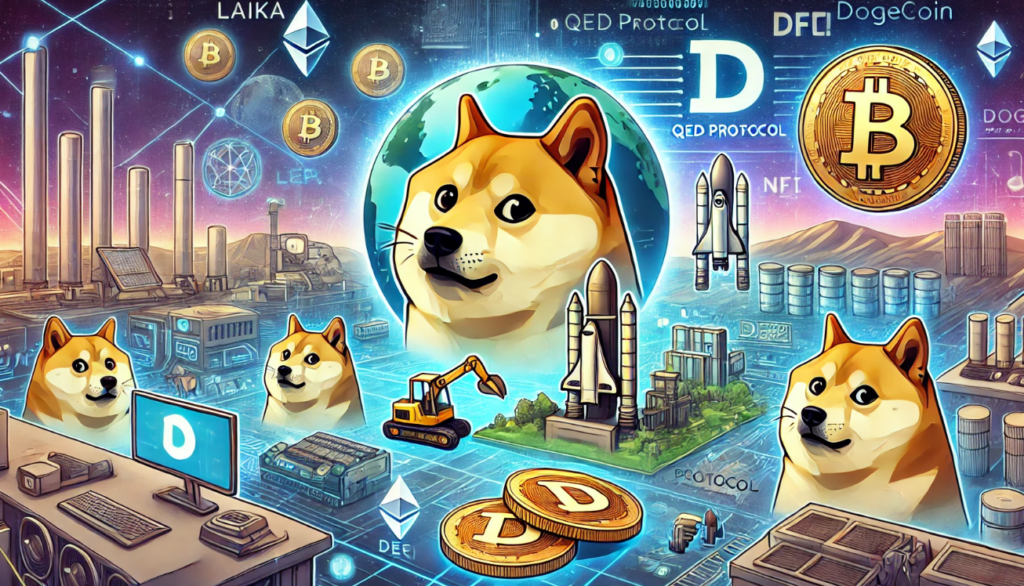Laika and Qed Protocol Leading the Charge
An increasing number of projects are working to bring smart contract functionality to the Dogecoin ecosystem, aiming to elevate the network beyond its origins as a light-hearted fork of Litecoin. Among these projects, Laika and Qed Protocol are making significant strides.
Laika’s Mainnet Launch
On Sunday, Laika, a Layer 2 solution for Dogecoin, launched on mainnet. The project claims to be the first Layer 2 network in the Dogecoin ecosystem.
“Starting on July 28th, you will be able to interact with the first Layer 2 on Dogecoin and become one of the earliest users of DogFi,” the Laika Foundation announced on Medium.
Laika aims to improve transaction speeds and introduce smart contracts to Dogecoin. The project claims block confirmation speeds of 3 seconds, compared to one minute on Dogecoin. However, Laika’s testnet performance shows average block times of 4.3 seconds.
On its launch day, Laika’s testnet hosted 2,820 daily transactions, down from an all-time high of 24,600 transactions on July 16. Overall, the testnet has processed a total of 608,039 transactions and hosted 42,558 wallets. For comparison, the Dogecoin network processed 197,000 transactions on the same day, according to Messari.
Qed Protocol’s Proposal
On July 26, Qed Protocol proposed a new Dogecoin opcode to facilitate DeFi applications and NFTs natively on Dogecoin. The proposal has garnered support from major mining pools, including AntPool, ViaBTC, and F2Pool.
“With the introduction of this opcode… the Dogecoin Network will effectively be the first PoW secured chain at feature parity with blockchains like Ethereum and with the scalability of Solana,” said Feldman from Qed Protocol.
Qed Protocol is also developing a zero-knowledge Layer 2 rollup for Dogecoin, enhancing its capabilities further.
The Role of Dogechain
In 2022, Dogechain sought to pioneer smart contract functionality within the Dogecoin ecosystem. Using the Polygon Edge tech stack, Dogechain offers compatibility with the Ethereum Virtual Machine (EVM), allowing developers to port dApps built for EVM onto the network.
Dogechain processed nearly 46,000 transactions on July 28, down from around 103,500 transactions on July 3, according to the Dogechain explorer. Despite this activity, the network’s total value locked (TVL) is just $3.49 million, according to DeFi Llama.
Innovation in the Dogecoin Ecosystem
Developers have also introduced Doginals inscriptions and Cardinals to Dogecoin, inspired by the success of similar technologies on Bitcoin. In February 2023, Doginals inscriptions went live, followed by Cardinals in May 2023. The same month, the DRC-20 fungible token standard was launched on Dogecoin, drawing inspiration from Bitcoin’s BRC-20 standard.
Bridging Dogecoin to Smart Contract Networks
While some projects are introducing EVM capabilities to Dogecoin, others are enabling DOGE holders to bridge their tokens to networks that natively support smart contracts.
In June, the Dfinity Foundation began developing ckDOGE, an on-chain alternative to wrapped tokens that allows users to bridge DOGE onto the Internet Computer network using chain-key cryptography. This technology enables cross-chain interoperability without centralized architecture.
Flare Network is also developing a protocol for cross-chain DOGE bridging in the form of F-Assets, allowing the token’s use in smart contracts on the Flare network. Flare launched F-Assets in open beta on June 4 following its November 2023 testnet deployment.
The Dogecoin ecosystem is witnessing a wave of innovation as developers work to integrate smart contract functionality. Projects like Laika, Qed Protocol, and Dogechain are leading the charge, while new bridging technologies promise to enhance Dogecoin’s utility further. As these initiatives progress, Dogecoin may soon offer capabilities rivaling those of more established blockchain platforms.












